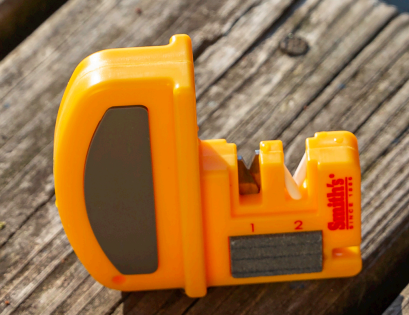
CURE SPRING FEVER WITH WALLEYE FISHING
FISHING AND CLEANING TIPS, ALONG WITH A DELICIOUS WALLEYE RECIPE
BY: KRISTINE OSTERTAG
It is that time of the year again when everyone anxiously awaits to wet a line again on the open water. Melting snow and rising water levels means one thing for most anglers, the walleye run is on. Walleyes take to the rivers each spring to lay their eggs, and anglers gather from all over to try and land themselves in the 30-inch club.
The males typically move in right after ice out, and the females follow as the water temp nears 40 degrees. The spawn can happen fast, depending on the weather, and most fish have spawned by the time the water reaches 50 degrees. One thing to remember during this time is to be bold and fish shallow. Walleyes typically will move into shallow areas with gravel or rock to spawn. Don’t be surprised if you find one sitting in a foot of water. During this time of year, tactics can range from pitching plastics, hair jigs, or trolling Dubuque rigs at slow speeds. For a more active bite, rippin raps and blade baits are common, along with trolling crankbaits. Don't be afraid to switch up if one thing isn't working. I have found that more natural colors work better before the water gets dirty, but brighter colors produce better once the clarity diminishes.
I love fishing for pre-spawn walleyes, but post-spawn can produce phenomenal fishing. During this time, the fish are hungry and actively feeding. Then, as spring rolls on, game fishing opens across the states, allowing people to keep walleyes on inland lakes. Check your state regulations for daily bag and size limits, as these vary.
There is nothing better than fresh walleye for dinner. There are many ways to eat walleye, but first, you must clean them. Ensuring you get all the bones out is essential, as no one wants to pick fish bones out of their teeth.
Here are a couple of tips to make this process a little easier:
- Before cleaning your fish, sharpen your knife. Nothing is worsethan a dull knife when trying to fillet a fish. Smiths ConsumerProducts makes an array of knife sharpeners. However, Irecommend the Smith’s Deluxe Knife and Hook Sharpener. It iscompact, easy to use, and always gives excellent results.

- A flexible blade is better, as it allows you to bend to the contour ofthe fish. I like to use the Smith’s Mr. Crappie 8-inch Curved SuperFlex Fillet Knife.

Steps for Cleaning:
- Place your knife behind the front fin and cut down to the backbone. DO NOT cut through the backbone.
- Once you make this cut, turn your fillet knife sideways, glide along the backbone down to the tail, and remove the fillet.
- Next, remove the rib bones. Place your fillet knife just behind the rib bones and follow the contour to do this.
- Next, you will remove the skin. Start at the tail, holding your knife sideways, and glide along the skin, removing the fillet as you go. Use your fingers to keep the skin in place as you do this.
- Lastly, you will remove the bones along the middle part of the fillet. To find these, run your fingers down the fillet. Once you find them make a cut along both sides of them and remove them.
- Wash the fillets in cold water, and they are ready to cook!
There are many ways to eat walleye, but one of my favorites is fish tacos. You can easily tweak them to make them your own. No fish taco is the same. Here is how I like to make them
WALLEYE FISH TACOS
Ingredients:
2 walleye fillets
1 cup Crispy Southern Zatarains fish fry
1 cup Cornmeal
Milk (used to dip fish in)
Olive oil (to fry in)
1 bag of coleslaw
1 jar of your favorite coleslaw dressing
Hard or soft shells (whichever you prefer)
Toppings of your choice ( red peppers, pico de gallo, pineapple salsa,
guacamole)
Prepping Toppings:
- Mix up coleslaw in a bowl and set aside.
- Cut up peppers and any other vegetables that you want and setaside.
- I usually purchase pico de gallo, pineapple salsa, andguacamole, but if you are ambitious, you can make these onyour own.

Cooking your walleye:
- In a bowl, mix Zatarains and cornmeal together
- In another bowl, add milk.
- Cut fillets into smaller pieces about 4-5 inches in length.
- Dip fish fillets in milk and then in the dry mix.
- In a frying pan, add enough olive oil to about 1/4 inch to coverthe bottom.
- Heat oil, and then add your battered fish fillets.
- Fry until crispy

Put the final product together by Putting your fish in the shell, followed by the coleslaw and the toppings, and it’s ready to eat!
MEDIA CONTACTS:
Dena Vick
dena@kingeiderpr.com
501-749-4575
Ricky Dukes
rdukes@smithsproducts.com
501-865-4227
ABOUT SMITH'S CONSUMER PRODUCTS:
Smith’s Consumer Products is an Arkansas-based company that traces its history to 1886. Smith’s produces the broadest line of knife and scissors sharpeners available, ranging from simple, fixed angle pull-through sharpeners for consumers that want quick and easy sharpening to sophisticated Precision Kits designed for the knife sharpening enthusiast. Our offering includes both manual and electrical sharpeners that incorporate many different abrasive materials, including diamond, carbide, ceramic, bonded synthetic abrasives, and of course, natural Arkansas stones. The Edge Experts at Smith’s Consumer Products also design and manufacture a wide range of tools for outdoor enthusiasts as well as knives for everyday carry, tactical, shop, kitchen, hunting, and fishing needs.
